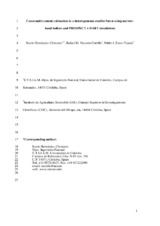Mostrar el registro sencillo del ítem
Carotenoid content estimation in a heterogeneous conifer forest using narrow-band indices and PROSPECT + DART simulations
| dc.contributor.author | Hernández Clemente, Rocío | |
| dc.contributor.author | Navarro Cerrillo, Rafael M. | |
| dc.contributor.author | Zarco-Tejada, Pablo J. | |
| dc.date.accessioned | 2024-01-31T12:01:19Z | |
| dc.date.available | 2024-01-31T12:01:19Z | |
| dc.date.issued | 2012 | |
| dc.identifier.issn | 1879-0704 | |
| dc.identifier.uri | http://hdl.handle.net/10396/26888 | |
| dc.description.abstract | The present study explored the use of narrow-band indices formulated in the visible spectral region at leaf and canopy levels to estimate carotenoid content. The research area was a pine forest affected by decline processes. Spectral reflectance and pigment content including chlorophylls a and b (Ca + b), carotenoid (Cx + c) and xanthophyll cycle pigments (VAZ) were measured in needles for two consecutive years. The study was conducted using radiative transfer modeling methods and high-resolution airborne imagery acquired at 10 nm FWHM bandwidth. Airborne data consisted of high spatial resolution imagery acquired with a narrow-band multispectral camera on board an unmanned aerial vehicle (UAV). The imagery had 50 cm resolution and six spectral bands in the 500–800 nm range, enabling the identification of pure crowns to obtain the reflectance of individual trees. The indices evaluated were traditional formulations and new simple ratios developed by combining bands sensitive to Cx + c absorption in the 500–600 nm region. The PROSPECT-5 model was coupled with the Discrete Anisotropic Radiative Transfer (DART) model to explore the performance of Cx + c-sensitive vegetation indices at leaf and canopy levels. The sensitivity of these indices to structural effects was assessed to study the potential scaling-up of Cx + c-related vegetation indices on heterogeneous canopies. Coefficients of determination between Cx + c content and narrow-band vegetation indices revealed that traditional indices were highly related with Cx + c content at leaf level (r2 > 0.90; P < 0.001 for the CRI index (1/R515)–(1/R550)) but highly affected by structural parameters at crown level (r2 > 0.44; P < 0.001). A new simple-ratio vegetation index proposed in this study (R515/R570) was found to be significantly related with Cx + c content both at leaf (r2 > 0.72; P < 0.001) and canopy levels (r2 > 0.71; P < 0.001). Remote sensing cameras on board UAV platforms can provide very high multispectral and hyperspectral imagery for mapping biochemical constituents in heterogeneous forest canopies. This study demonstrates the feasibility of mapping carotenoid content to assess the physiological condition of forests. | es_ES |
| dc.format.mimetype | application/pdf | es_ES |
| dc.language.iso | eng | es_ES |
| dc.publisher | Science Direct | es_ES |
| dc.rights | https://creativecommons.org/licenses/by-nc-nd/4.0/ | es_ES |
| dc.source | Remote Sensing of Environment, Vol 127, Pages 298-315 (2012) | es_ES |
| dc.subject | Narrow-band indices | es_ES |
| dc.subject | Carotenoids R515/R570 | es_ES |
| dc.subject | Radiative transfer | es_ES |
| dc.subject | Airborne remote sensing | es_ES |
| dc.subject | UAV | es_ES |
| dc.subject | Heterogeneous conifer forest | es_ES |
| dc.title | Carotenoid content estimation in a heterogeneous conifer forest using narrow-band indices and PROSPECT + DART simulations | es_ES |
| dc.type | info:eu-repo/semantics/article | es_ES |
| dc.relation.publisherversion | https://doi.org/10.1016/j.rse.2012.09.014 | es_ES |
| dc.relation.projectID | Junta de Andalucía. P06-RNN-1890 | es_ES |
| dc.relation.projectID | Gobierno de España. AGL2009-13105 | es_ES |
| dc.rights.accessRights | info:eu-repo/semantics/openAccess | es_ES |

